Blue Ox Towing Guide: Chapter 1
CHAPTER 1: CHOOSING THE RIGHT SETUP
BLUE OX TOWING GUIDE
Choosing The Right Towing Setup Overview
Choosing the proper towing setup is crucial for following safe towing practices. The equipment you choose will vary depending on various factors, such as what you will be towing, towing capacities, and road conditions.
What Will You Be Towing?
Choosing the right trailer will depend on what you plan on towing because not all trailers are suited for every towing scenario. Trailers have different purposes, weight limitations, and hitch types that must be considered when choosing your towing setup.
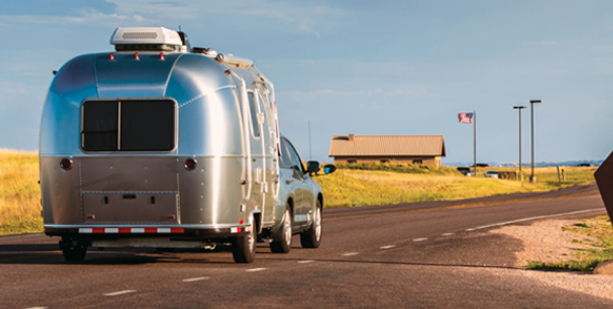
Different Towing Methods
Standard Towing
Standard towing includes towing a boat, a utility trailer, or another type of conventional trailer.
Flat Towing
Flat towing is often used to tow a car behind a motorhome and all four-wheels of the towed vehicle are on the ground.
Travel Trailer Towing
Travel trailer towing can be more complex than standard towing because the weight of the trailer is often much heavier and requires additional equipment to tow safely.
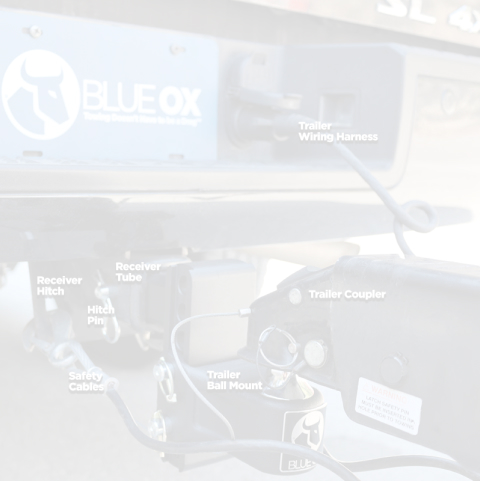
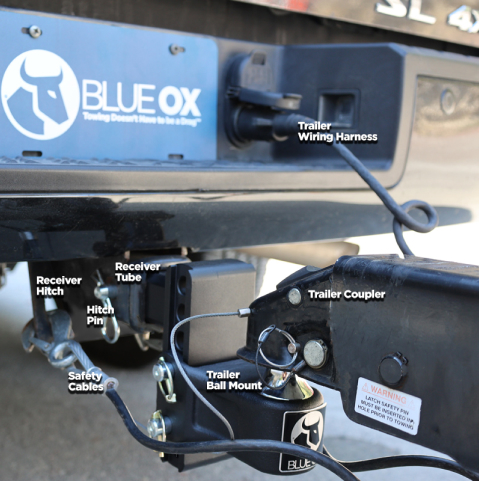

Basic Parts of a Trailer Hitch
A towing system can be viewed in three parts: the trailer, vehicle, and equipment connecting the two. Regardless of the type of trailer you will be towing, the trailer hitch is a key component. Within the trailer hitch itself, there are several additional necessary parts. The diagram below shows how all aspects work together, but let’s break it down part by part.

Trailer Hitch
The trailer hitch, also known as a tow hitch, is the main connection point between the trailer and the tow vehicle. It is attached to the chassis of the tow vehicle. A receiver hitch is another type of trailer hitch that may be designed for a specific vehicle, but it is also very common, and the term is often used interchangeably with trailer hitch.
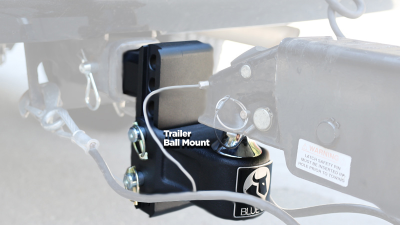
Ball Mount
The ball mount is inserted into the trailer hitch. Its design uses a shank (inserted into the trailer hitch) and a trailer ball platform (the point where the trailer is mounted). Most ball mounts have a hole in the shank for inserting a hitch lock or pin. Ball mounts with the trailer ball already attached are also referred to as a ball hitch, so you may see both terms frequently.
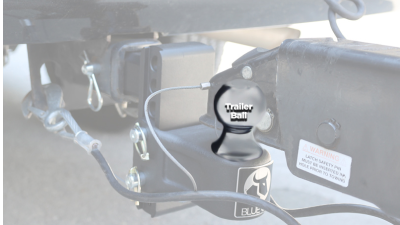
Trailer Ball
The trailer ball is the point where the trailer actually connects to your vehicle. Also known as a hitch ball, these metal spheres help create a better ride by making turns, bumps, and hills smoother. There are a few standard sizes for trailer balls, so finding the right one for your trailer shouldn’t be too difficult.
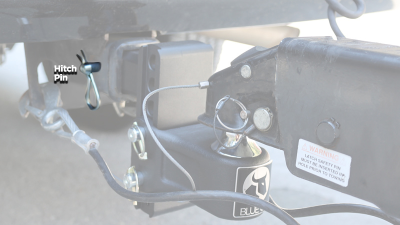
Hitch Pin
Once the ball mount is inserted into the trailer hitch, a hitch pin will need to be inserted to keep the two from sliding apart. Generally, a hitch pin is an “L” shaped piece of metal designed to be inserted through the ball mount shank, and a hairpin-shaped clip will be used on the other end to keep the hitch pin from falling out. A hitch lock can also be used. It functions similarly to a hitch pin, but uses a padlock or cap that is opened with a key to protect your trailer from theft.
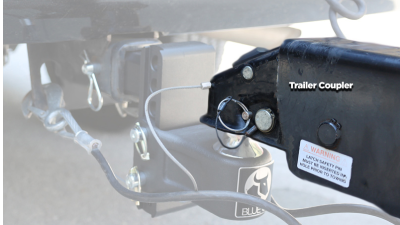
Trailer Coupler
The trailer coupler is the piece on the forward-most part of the trailer that directly attaches to the trailer ball. Trailer couplers allow the trailer to pivot more freely and are often adjustable to ensure a safe, smooth ride.

Safety Chains
Safety chains are strong metal chains attached to the trailer and tow vehicle. If, for any reason, one of the other safety measures were to fail, two safety chains should be in place to keep the trailer from completely separating from the tow vehicle.
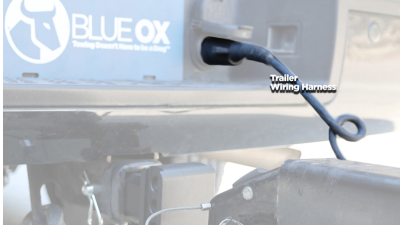
Trailer Wiring Harness
The trailer wiring harness connects the electrical system of the tow vehicle to the trailer to power on its lights. This is crucial when towing so that other drivers on the road know when you are braking and turning. It is also important when connecting trailer brakes.
Types of Hitches and Classes
Receiver Hitch
A receiver hitch is one of the most common types of trailer hitches. These are mounted to the frame of the tow vehicle and have a tube extending out for the ball mount to be inserted. Their towing capacity may vary depending on what class they are in, but most are at least up to 2,000 lbs.
5th Wheel Hitch
5th wheel hitches are used for pickup trucks only and use a plate for the trailer tongue to rest and a trailer kingpin. These hitches are mounted in the bed of the truck. They are a better design for medium to heavy-duty towing, often up to 30,000 lbs, because the load of the trailer is placed over the rear axle of the truck rather than behind it, so it creates more towing power.
Gooseneck Hitch
A gooseneck hitch is a heavy-duty hitch type that also places the load of the trailer over the rear axle of the truck and uses a hitch ball fitted to the truck bed. The trailer is then lowered onto the ball and secured. Gooseneck hitches offer a higher towing capacity up to 38,000 lbs and are relatively lightweight for how much weight they can handle.
Pintle Hitch
A pintle hitch is not as common but can be useful for heavy-duty towing where a flexible link pivot is necessary. This heavy-duty hook and jawed style hitch attaches to the tow vehicle's rear and makes towing in rugged terrain easier. A pintle hitch can tow up to 60,000 lbs.
Weight Distribution Hitch
A weight distribution hitch is a slightly different type of hitch. It doesn’t pull the full weight of the trailer; rather it helps distribute the weight between the trailer and tow vehicle to prevent trailer sway and make for a smoother ride. A weight distribution hitch is an essential piece of equipment for towing safely.
Class Selection
Hitch Class 1 Hitch Class 2 Hitch Class 3 Hitch Class 4 Class 5 Xtra Duty Class 5 Commercial Duty
Towing Capacities and Legal Requirements
Towing capacity is considered the maximum amount of weight your tow vehicle can pull safely. This number can change depending on various factors like how much weight the tow vehicle is already carrying and how the weight is distributed. Determining towing capacity requires a series of calculations that all factor into what weight is within your vehicle's limit.
Towing Terms To Know
How to Calculate Towing Capacity
You will always need to consult the owner's manual for your vehicle when calculating towing capacity. Many vehicles also have the towing capacity listed on the door jamb of the driver's side, so you can access it easily. The total weight of the trailer you are towing should not exceed the vehicle's rating, even if your trailer is weighted to pull more. When in doubt, never exceed the lowest-rated component of your towing setup.
The most important numbers to know are the GVWR, GTW, and GCWR. The GCWR should be less than the total of the GVWR and GTW. You can use this simplified equation:
GVWR + GTW < GCWR
Legal Requirements for Towing
Aside from knowing the weight capacities for towing, there are also legal requirements you must follow to ensure you are towing safely. Towing laws vary by state, so it is important to check your local requirements before hitting the road. However, some general towing requirements you may encounter include:
- • Maximum weight limits
- • Trailer reflectors
- • Use of trailer brakes
- • Trailer turn signals
- • Trailer brake light requirements
- • Trailer insurance
- • Trailer licensing and registration
- • Tie downs for cargo
- • Safety chain protocols
- • Breakaway brakes for trailer
What Road Conditions Will You Encounter?
Uneven Road Conditions
Whether you will be driving down rural roads or roads with many potholes, being prepared is important. Make sure you have cargo strapped down and secured properly while reducing speed through bumpy areas. Hitting big bumps could jostle your cargo loose and affect how evenly the weight is distributed or worse; your cargo could end up on the road.
Wet Roads
You will need to drive with more caution when you are towing a trailer while it's raining or shortly after rainfall. Water can pool on roads and cause hydroplaning, which is dangerous whether you are towing a trailer or not. The chances you will experience trailer sway increase when roads are wet, so installing a sway control device will help. However, it's primarily your responsibility as the driver to reduce speed and drive with caution.
Snow and Ice
If you can avoid towing your trailer in snow or ice, this is ideal, but if you must, you will need to use the utmost caution. Greatly reduce your speed, avoid braking suddenly, and install sway control equipment to prevent trailer sway, which could quickly cause an accident.
Windy Conditions
Wind gusts are often unexpected and unavoidable and can make controlling your vehicle challenging. Whether the wind is caused by a passing truck or the weather, it can create trailer sway or blow poorly secured cargo off into the road, so be aware of this when planning your travel.
